Do you have a question about the Triumph Speed Triple S and is the answer not in the manual?
Explains symbols used for safety instructions and important information.
Details on warning labels and their meanings for rider safety.
Safety considerations specific to the motorcycle's design and usage.
Hazards and precautions related to fuel flammability and exhaust fumes.
Essential protective gear required for safe riding.
Safety guidelines and precautions for parking the motorcycle.
Identification and placement of warning labels on the motorcycle.
Diagrams and labels identifying key motorcycle components.
Location and recording of the Vehicle Identification Number (VIN).
Location and recording of the Engine Serial Number.
General overview of the motorcycle's instrument cluster.
Detailed description of the dashboard display and indicators.
Instructions on navigating the instrument menus and controls.
Explanation of the MIL warning light and its implications for engine performance.
How the ABS warning light functions and indicates system status.
Explanation of the TC indicator light and its operation during riding.
Indicates the status and activation of the cruise control system.
Information on road speed indication and total distance traveled.
Engine speed indicator and warnings regarding red zone operation.
Indicates the currently engaged gear of the transmission.
Explanation of different riding modes and their settings.
Procedure for selecting and changing between riding modes.
Accessing and displaying various motorcycle status information.
Accessing core motorcycle settings and configurations.
Options for configuring motorcycle features and systems.
Instructions for temporarily disabling the ABS system.
Instructions for temporarily disabling the Traction Control system.
Configuration options for trip meters.
Options for customizing the appearance of the display screen.
Restoring instrument settings to factory default values.
Adjusting the display for optimal rider visibility and safety.
Description of controls located on the handlebars.
Operation and features of the keyless ignition system.
Operation of the ignition switch and steering lock mechanism.
Description of controls on the right handlebar.
Description of controls on the left handlebar.
How to adjust the set speed while cruise control is active.
Description of the electronic throttle and its operational checks.
General operation, safety, and conditions for using cruise control.
Step-by-step instructions and conditions for engaging cruise control.
Methods and procedures for disengaging cruise control.
Operation, warnings, and precautions for the TPMS.
Correct tyre pressures and procedures for checking and adjusting them.
Information on the fuel system and recommended fuel grade.
Safety precautions and procedures for refuelling the motorcycle.
Proper technique for filling the fuel tank to prevent spillage.
Information on seats, including care and removal procedures.
Operation and safety precautions related to the side stand.
Procedure and guidelines for the initial break-in period of the motorcycle.
Critical pre-ride checks to ensure safe motorcycle operation.
Procedures for safely stopping the motorcycle's engine.
Procedures for safely starting the motorcycle's engine.
Safe and effective braking techniques and warnings.
Explanation of ABS functionality, operation, and warnings.
Safe practices and guidelines for parking the motorcycle.
Precautions and advice for riding the motorcycle at high speeds.
Guidelines for adding accessories and their impact on motorcycle operation.
Proper weight distribution, security, and limits for loads.
Safety and operational considerations when carrying a passenger.
Overview of the scheduled maintenance program and its importance.
Detailed schedule of maintenance tasks based on mileage and time.
Information regarding engine oil, its importance, and level checks.
Procedure for changing the engine oil and oil filter.
Importance of engine cooling and checks for coolant and related components.
Procedure for inspecting the coolant level in the expansion tank.
Procedure for adjusting the coolant level.
Information regarding the fuel tank and procedures for raising it.
Information on clutch operation, inspection, and adjustment.
Information on drive chain maintenance, lubrication, and inspection.
Procedure for inspecting chain and sprocket wear.
General information and inspection procedures for the braking system.
Procedure for inspecting brake pad and disc wear.
How to check and adjust brake fluid levels in reservoirs.
Instructions for adjusting and cleaning mirrors for optimal rearward vision.
How to inspect the steering system for proper adjustment and faults.
Procedure for inspecting front and rear wheel bearings.
How to inspect the front forks for damage, leaks, and smooth operation.
Recommended suspension settings for the Speed Triple S model.
Recommended suspension settings for the Speed Triple RS model.
Procedures for adjusting front suspension components like preload and damping.
Overview of rear suspension adjustability for rebound and compression damping.
Information on tyre specifications, pressures, and maintenance.
Correct tyre pressures and their importance for stability and safety.
Importance of tyre tread depth and wear for safe operation.
Guidelines for approved tyres, combinations, and proper fitting.
Safety precautions and handling procedures for the motorcycle battery.
Step-by-step procedure for safely removing the motorcycle battery.
Procedures and safety precautions for charging the motorcycle battery.
Procedure for safely installing the motorcycle battery.
Location and identification of fuse boxes and individual fuses.
How to identify blown fuses and their protected circuits.
Information on headlight adjustment and safety precautions.
How to adjust the vertical beam angle of the headlights.
Procedure for replacing headlight bulbs, including safety warnings.
Procedure for replacing the license plate light bulb.
General guidance on cleaning and storing the motorcycle.
Precautions to take before washing the motorcycle.
Proper techniques and materials for washing the motorcycle.
Steps to take after washing, including drying and testing components.
Instructions for maintaining the appearance of gloss paintwork.
Instructions for maintaining the appearance of matt paintwork.
Cleaning procedures for unpainted aluminium parts.
Procedures for cleaning chrome and stainless steel motorcycle parts.
Guidelines for cleaning the motorcycle's exhaust system.
Instructions for cleaning and maintaining the motorcycle seat.
Procedure for cleaning the windscreen safely.
Steps to prepare the motorcycle for long-term storage.
Steps to take after the motorcycle has been stored to ensure readiness.
Key physical dimensions, weights, and performance figures of the motorcycle.
Technical specifications of the motorcycle's engine.
Technical specifications of the fuel injection and delivery system.
Specifications related to the transmission, clutch, and drive ratios.
Specifications for tyre sizes, pressures, and approved types.
Specifications for torque settings of various fasteners and components.
Alphabetical reference guide to topics covered in the manual.
Regulatory compliance and approval details for the US and Canada.
Procedure for safely replacing the smart key battery.
Explains symbols used for safety instructions and important information.
Details on warning labels and their meanings for rider safety.
Safety considerations specific to the motorcycle's design and usage.
Hazards and precautions related to fuel flammability and exhaust fumes.
Essential protective gear required for safe riding.
Safety guidelines and precautions for parking the motorcycle.
Identification and placement of warning labels on the motorcycle.
Diagrams and labels identifying key motorcycle components.
Location and recording of the Vehicle Identification Number (VIN).
Location and recording of the Engine Serial Number.
General overview of the motorcycle's instrument cluster.
Detailed description of the dashboard display and indicators.
Instructions on navigating the instrument menus and controls.
Explanation of the MIL warning light and its implications for engine performance.
How the ABS warning light functions and indicates system status.
Explanation of the TC indicator light and its operation during riding.
Indicates the status and activation of the cruise control system.
Information on road speed indication and total distance traveled.
Engine speed indicator and warnings regarding red zone operation.
Indicates the currently engaged gear of the transmission.
Explanation of different riding modes and their settings.
Procedure for selecting and changing between riding modes.
Accessing and displaying various motorcycle status information.
Accessing core motorcycle settings and configurations.
Options for configuring motorcycle features and systems.
Instructions for temporarily disabling the ABS system.
Instructions for temporarily disabling the Traction Control system.
Configuration options for trip meters.
Options for customizing the appearance of the display screen.
Restoring instrument settings to factory default values.
Adjusting the display for optimal rider visibility and safety.
Description of controls located on the handlebars.
Operation and features of the keyless ignition system.
Operation of the ignition switch and steering lock mechanism.
Description of controls on the right handlebar.
Description of controls on the left handlebar.
How to adjust the set speed while cruise control is active.
Description of the electronic throttle and its operational checks.
General operation, safety, and conditions for using cruise control.
Step-by-step instructions and conditions for engaging cruise control.
Methods and procedures for disengaging cruise control.
Operation, warnings, and precautions for the TPMS.
Correct tyre pressures and procedures for checking and adjusting them.
Information on the fuel system and recommended fuel grade.
Safety precautions and procedures for refuelling the motorcycle.
Proper technique for filling the fuel tank to prevent spillage.
Information on seats, including care and removal procedures.
Operation and safety precautions related to the side stand.
Procedure and guidelines for the initial break-in period of the motorcycle.
Critical pre-ride checks to ensure safe motorcycle operation.
Procedures for safely stopping the motorcycle's engine.
Procedures for safely starting the motorcycle's engine.
Safe and effective braking techniques and warnings.
Explanation of ABS functionality, operation, and warnings.
Safe practices and guidelines for parking the motorcycle.
Precautions and advice for riding the motorcycle at high speeds.
Guidelines for adding accessories and their impact on motorcycle operation.
Proper weight distribution, security, and limits for loads.
Safety and operational considerations when carrying a passenger.
Overview of the scheduled maintenance program and its importance.
Detailed schedule of maintenance tasks based on mileage and time.
Information regarding engine oil, its importance, and level checks.
Procedure for changing the engine oil and oil filter.
Importance of engine cooling and checks for coolant and related components.
Procedure for inspecting the coolant level in the expansion tank.
Procedure for adjusting the coolant level.
Information regarding the fuel tank and procedures for raising it.
Information on clutch operation, inspection, and adjustment.
Information on drive chain maintenance, lubrication, and inspection.
Procedure for inspecting chain and sprocket wear.
General information and inspection procedures for the braking system.
Procedure for inspecting brake pad and disc wear.
How to check and adjust brake fluid levels in reservoirs.
Instructions for adjusting and cleaning mirrors for optimal rearward vision.
How to inspect the steering system for proper adjustment and faults.
Procedure for inspecting front and rear wheel bearings.
How to inspect the front forks for damage, leaks, and smooth operation.
Recommended suspension settings for the Speed Triple S model.
Recommended suspension settings for the Speed Triple RS model.
Procedures for adjusting front suspension components like preload and damping.
Overview of rear suspension adjustability for rebound and compression damping.
Information on tyre specifications, pressures, and maintenance.
Correct tyre pressures and their importance for stability and safety.
Importance of tyre tread depth and wear for safe operation.
Guidelines for approved tyres, combinations, and proper fitting.
Safety precautions and handling procedures for the motorcycle battery.
Step-by-step procedure for safely removing the motorcycle battery.
Procedures and safety precautions for charging the motorcycle battery.
Procedure for safely installing the motorcycle battery.
Location and identification of fuse boxes and individual fuses.
How to identify blown fuses and their protected circuits.
Information on headlight adjustment and safety precautions.
How to adjust the vertical beam angle of the headlights.
Procedure for replacing headlight bulbs, including safety warnings.
Procedure for replacing the license plate light bulb.
General guidance on cleaning and storing the motorcycle.
Precautions to take before washing the motorcycle.
Proper techniques and materials for washing the motorcycle.
Steps to take after washing, including drying and testing components.
Instructions for maintaining the appearance of gloss paintwork.
Instructions for maintaining the appearance of matt paintwork.
Cleaning procedures for unpainted aluminium parts.
Procedures for cleaning chrome and stainless steel motorcycle parts.
Guidelines for cleaning the motorcycle's exhaust system.
Instructions for cleaning and maintaining the motorcycle seat.
Procedure for cleaning the windscreen safely.
Steps to prepare the motorcycle for long-term storage.
Steps to take after the motorcycle has been stored to ensure readiness.
Key physical dimensions, weights, and performance figures of the motorcycle.
Technical specifications of the motorcycle's engine.
Technical specifications of the fuel injection and delivery system.
Specifications related to the transmission, clutch, and drive ratios.
Specifications for tyre sizes, pressures, and approved types.
Specifications for torque settings of various fasteners and components.
Alphabetical reference guide to topics covered in the manual.
Regulatory compliance and approval details for the US and Canada.
Procedure for safely replacing the smart key battery.
| Displacement | 1050 cc |
|---|---|
| Transmission | 6-speed |
| Fuel Capacity | 15.5 liters |
| Seat Height | 825 mm |
| Dry Weight | 192 kg |
| Engine Type | Liquid-cooled, 12 valve, DOHC, inline 3-cylinder |
| Frame | Aluminum twin spar |
| Rear Suspension | Showa monoshock with adjustable rebound and compression damping |
| Front Brakes | Twin 320 mm floating discs, Brembo 4-piston radial calipers, ABS |
| Front Suspension | Showa 43 mm upside down forks with adjustable rebound and compression damping |
| Rear Brakes | Single 255 mm disc, Nissin 2-piston caliper, ABS |

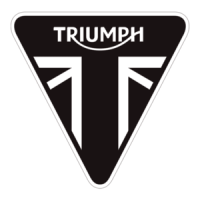



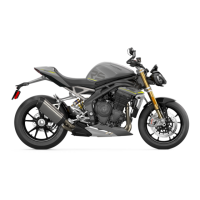

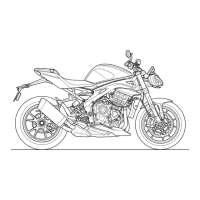
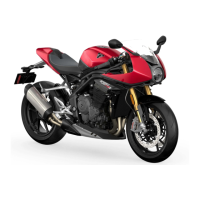
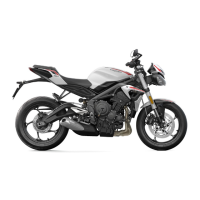
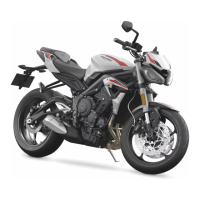
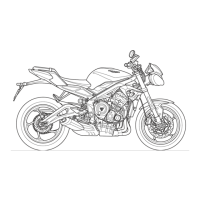
